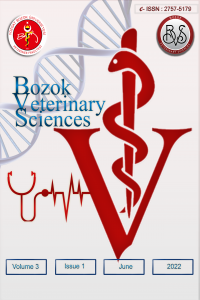Medikal Ozonun Deri Lezyonlarının İyileşmesi Üzerine Etkileri
Ozon, Deri, Yara, İyileşme mekanizması, Ozone, Skin, Wound, Mechanism of healing
Effects of Medical Ozone on Healing of Skin Lesions
Ozon, Deri, Yara, İyileşme mekanizması, Ozone, Skin, Wound, Mechanism of healing,
___
- 1. Beldon P. Basic science of wound healing. Surgery 2010; 28(9); 409-412. doi: 10.1016/j.mpsur.2010.05.007.
- 2. Borges GA, Elias ST, Silva SMM, Magalhaes PO, Macedo SB et al. In vitro evaluation of wound healing and antimicrobial potential of ozone therapy. J Craniomaxillofac Surg 2017; 45(3); 364-370. doi: 10.1016/j.jcms.2017.01.005.
- 3. Broughton G, Janis JE, Attinger CE. The basic science of wound healing. Plast Reconstr Surg 2006; 117(7); 12-34. doi: 10.1097/01.prs.0000225430.42531.c2.
- 4. Canedo-Dorantes L, Canedo-Ayala M. Skin acute wound healing: A compherensive review. J Inflamm Res 2019; 19(1); 1-15. doi: 10.1155/2019/3706315.
- 5. Coelho CS, Bernadi WA, Ginelli AM, Spagnol T, Gardel SL et al. Use of ozone therapy in chronic laminitis in a horse. J Ozone Ther 2015; 1(1); 1-6. 6. Fitzpatrick E, Holland OJ, Vanderlelie JJ. Ozone therapy for the treatment of chronic wounds: A systematic review. Int Wound J 2018; 15(4); 633-644. doi: 10.1111/iwj.12907.
- 7. Gantwerker EA, Hom DB. Skin: Histology and physiology of wound healing. Clin Plast 2012; 39(1); 85-97. doi: 10.1016/j.cps.2011.09.005.
- 8. Gulmen S, Kurtoglu T, Meteoglu I, Kaya S, Okutan H. Ozone therapy as an adjunct to vancomycin enhances bacterial elimination in methicillin resistant staphylococcus aureus mediastinitis. J Surg Res 2013; 185(1); 64-69. doi: 10.1016/j.jss.2013.05.085.
- 9. Kozat S, Okman EN. Has ozone therapy a future in veterinary medicine? J Anim Sci 2019; 3(1); 25-34.
- 10. Lai-Cheong JE, McGrath JA. Structure and function of skin, hair and nails. Medicine (UK) 2013; 41(6); 317-320. doi: 10.1016/j.mpmed.2013.04.017.
- 11. Mohammed Al-Dalain S, Martinez G, Candelario-Jalil E, Menendez S, Re L et al. Ozone treatment reduces markers of oxidative and endothelial damage in an experimental diabetes model in rats. Pharmacol Res 2001; 44(5); 391-396. doi: 10.1006/phrs.2001.0867.
- 12. Maslennikov OV, Kontorshcikova CN, Gribkova IA. Ozone therapy in practice Health Manual, Ministry Health Service of the Russian Federation The State Medical Academy of Nizhny Novgorod. Russia, 2008.
- 13. Nogales CG, Ferrari PH, Kantorovich EO, Lage-Marques J. Ozone therapy in medicine and dentistry. J Contemp Dent 2008; 9(4); 1-9. doi: 10.5005/jcdp-9-4-75.
- 14. Pchepiorka R, Moreira MS, Lascane NA, Catalani LH, Allegrini S et al. Effect of ozone therapy on wound healing in the buccal mucosa of rats. Arch Oral Biol 2020; 119(1); 1-7. doi: 10.1016/j.archoralbio.2020.104889.
- 15. Peteoca A, Istrate A, Goanta AM, Ionuşcu I, Tarase A. The use of ozone therapy in veterinary medicine: a systematic review. AgroLife Sci J 2020; 9(2); 226-239.
- 16. Pivotto AP, Banhuk FW, Staffen IV, Daga MA, Ayala TS et al. Clinical uses and molecular aspects of ozone therapy: A review. Online J Biol Sci 2020; 20(1); 37-49. doi: 10.3844/ojbsci.2020.37.49.
- 17. Reinke JM, Sorg H. Wound repair and regeneration. Eur Surg Res 2012; 49(1); 35-43. doi: 10.1159/000339613.
- 18. Rodrigues M, Kosaric N, Bonham CA, Gurtner GC. Wound healing: a celluler perspective. Physiol Rev 2019; 99(1); 665-706. doi: 10.1152/physrev.00067.2017.
- 19. Rosul MV, Patskan MB. Ozone therapy effectiviness in patients with ulcerous lesions due to diabetes mellitus. Wiadomosci Lekarskie 2016; 69(1); 7-9.
- 20. Sciorsci RL, Lillo E, Occhiogrosso L, Rizzo A. Ozone therapy in veterinary medicine: A review. Res Vet Sci 2020; 130; 240-246. doi: 10.1016/j.rvsc.2020.03.026.
- 21. Singh S, Young A, McNaught CE. The physiology of wound healing. Surgery 2017; 35(9); 473-477. doi: 10.1016/j.mpsur.2017.06.004.
- 22. Soares CD, Morais TM, Araujo RM, Meyer PF, Oliviera EA et al. Effects of subcutaneous injection of ozone during wound healing in rats. Growth Factors 2019; 37(1-2); 95-103. Doi: 10.1080/08977194.2019.1643339.
- 23. Sorg H, Tilkorn DJ, Hager S, Hauser J, Mirastschijski U. Skin wound healing: an update on the current knowledge and concepts. Eur Surg Res 2017; 58(1-2); 81-94. doi: 10.1159/000454919.
- 24. Sunnen GV. Ozone in medicine: overview and future directions. J Adv Med 1988; 1(3); 159-174.
- 25. Sunnen GV. Ozone, nitric oxide and avian influenza; preliminary theoretical considerations and possible directions. Ozonics International 2005.
- 26. Svystonyuk DA, Ngu J, Mewhart HE, Lipon BD, Teng G et al. Fibroblast growth factor-2 regulates human cardiac myofibroblast mediated extracellular matrix remodeling. J Transl Med 2015; 13(1); 1-11. doi: 10.1186/s12967-015-0510-4.
- 27. Wen Q, Liu D, Wang X, Zhang Y, Fang S et al. A systematic review of ozone therapy for treating chronically refractory wounds and ulcers. Int Wound J 2022; 19; 853-870. doi: 10.1111/iwj.13687.
- 28. Viebahn-Haensler R. Milestones of medical ozone. Rev Soc Esp Dolor 2005; 12(2); 3-9.
- 29. Zeng J, Lu J. Mechanisms of action involved in ozone-therapy in skin diseases. Int Immunopharmacol 2018; 56(138); 235-241. doi: 10.1016/j.intimp.2018.01.040
- Yayın Aralığı: Yılda 2 Sayı
- Başlangıç: 2020
- Yayıncı: Yozgat Bozok Üniversitesi
Kadır BOZUKLUHAN, Oguz MERHAN, Fatih BUYUK, Enes AKYÜZ, Tahir GEZER, Hale ERGİN EĞRİTAĞ, Gürbüz GOKCE
Medikal Ozonun Deri Lezyonlarının İyileşmesi Üzerine Etkileri
Nevzat Emre ASLAN, Hanıfı EROL
Siirt Otlu Peynirinin Teknik, Fiziksel, Kimyasal ve Mikrobiyolojik Analizleri
Murat GÜLMEZ, Kübranur YILDIZ BAYHAN, Sefa ÜNER
Kerem URAL, Hasan ERDOĞAN, Songül ERDOĞAN
Marwa JAWAD, Zahraa MOHAMMED, Firas ALALİ, Saeed EL-ASHRAM, Asaad Sh. M. ALHESNAWİ
